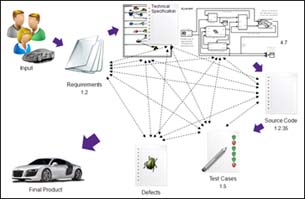Latest News
December 4, 2001
By Anthony J. Lockwood
Dear Desktop Engineering Reader:
 |
Thirty years ago, product development cycles, time to market pressures, and compliance standards were almost quaint compared to what they are today. Modeling and testing meant pen and paper and then burning out expensive prototypes. Processes were managed with file folders, whiteboards, and the phone.
Today’s products are complex assemblies of electronics, materials, parts, and subassemblies designed, simulated, and manufactured globally. At the heart of just about every product today is a chip or a collection of chips with embedded code developed exclusively for that product. How do you manage the lifecycle of that embedded code? How is that code’s life integrated into the product’s lifecycle?
Chances are that you have some sort of PLM system to manage your CAD models and PDM to manage your bills of materials and things. Chances are also good that you have an isolated – and perhaps ad hoc—project management process to manage the modeling, simulation, configurations, engineering change orders, and what have you of the code at the heart of your product. That means that while you have coordinated the design, analysis, and manufacture of your product, the code that gives your product its uniqueness and that is often your most expensive development area is disconnected from the rest of your organization. It’s like the brass doing Sousa while the rest of the orchestra does Bach.
The costs this disconnect racks up include missed deadlines, squandered opportunities for design reuse, difficulties tracking compliance auditing, intellectual property scattered across the organization, recalls, and no single source of truth for everything that is your product. And that is just to name a few.
This is the basic thesis of today’s Check It Out read. Entitled “Harmonizing Modeling & Simulation with the Development Lifecycle,” this 10-page PDF does a terrific job making its case for a better way to effectively manage all the processes that are the lifecycle of embedded code then integrate that knowledge with the rest of the organization. The author, writing for MKS, naturally makes the argument that MKS Integrity is the solution. And it could well be. That’s for you to decide.
Still, at every organization I’ve worked at for the past 30 years, software development costs routinely went through the roof. Often, nobody—not even the programming teams themselves – really could convince me that they had handle on what was going on. They could say it would take 30 hours and cost so much to add a feature to something. They could not adequately explain why, and I had no insight into their process to know why.
The MKS business proposition that embedded software modeling and simulation needs to come out of the shadows and integrate with the rest of the product data in a well-managed lifecycle seems spot on to me. Actually, a no-brainer. But, as I said, read this paper and decide for yourself.
Thanks, pal.—Lockwood
Anthony J. Lockwood
Editor at Large, Desktop Engineering
Check out “Harmonizing Modeling & Simulation with the Development Lifecycle.”
Subscribe to our FREE magazine, FREE email newsletters or both!
Latest News
About the Author
Anthony J. Lockwood is Digital Engineering’s founding editor. He is now retired. Contact him via [email protected].
Follow DE





